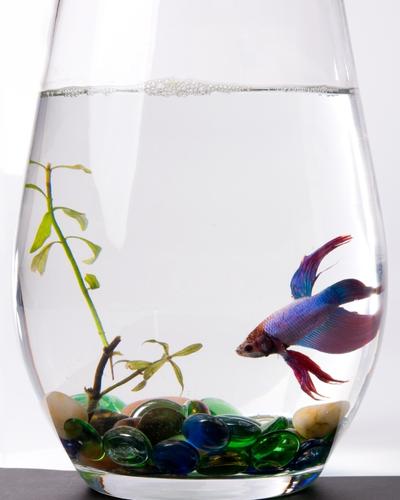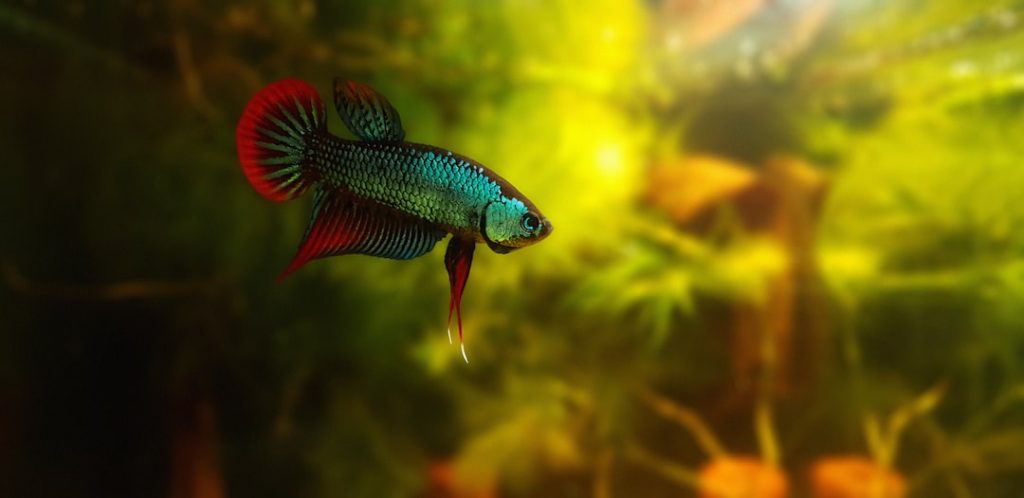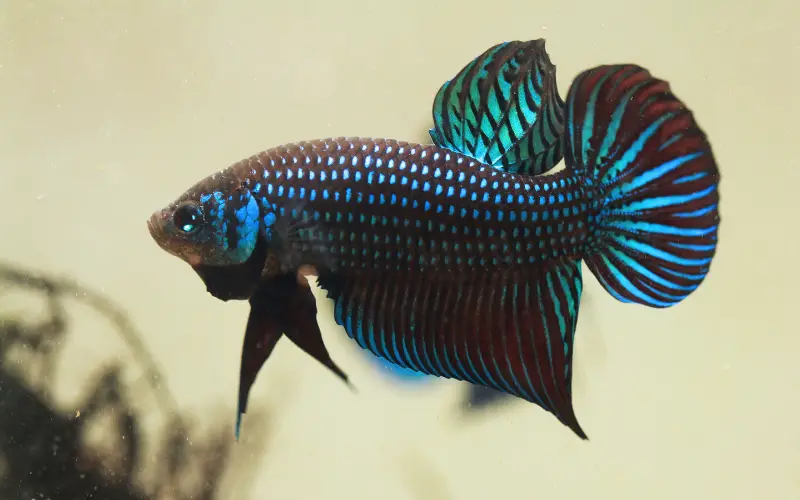Are wild bettas aggressive? If you’ve ever kept fish, you know that wild bettas can sometimes be difficult to manage due to their aggression.
This common problem can be addressed with the right solutions, which is why we’ve created this comprehensive guide for all fish keepers looking to learn more about taming wild bettas.
We will discuss a wild betta’s behavior and how it differs from other betta species.
We will also provide five tested solutions to help them acclimate to the tank environment and reduce their aggressive tendencies.

Read on if you’d like to create a peaceful species oasis in your aquarium!
Table of Contents
Toggledo betta fish live in the wild?
Yes, betta fish do live in the wild! In fact, there are over 70 different species of betta fish found throughout Southeast Asia, in countries like Thailand, Vietnam, Indonesia, and Malaysia.
These vibrant fish typically make their homes in shallow, freshwater habitats like rice paddies, swamps, and slow-moving streams. The water in these areas is often warm and stagnant, which is why bettas kept as pets also need warm water in their aquariums.

In the wild, betta fish are solitary creatures and fiercely defend their territories. They’re known for their aggressive behavior, especially towards other male bettas. This is why they’re often called “fighting fish” or “Siamese fighting fish.”
Despite their aggressive nature, betta fish are also beautiful and fascinating creatures. They come in a wide variety of colors and fin shapes, and they’re relatively easy to care for in captivity. If you’re thinking about getting a betta fish as a pet, be sure to do your research to make sure you can provide it with the proper care.
Are Wild Bettas Aggressive? (Wild Betta Fish Habitat)
Are Bettas aggressive to other fish? In the wild, domestic bettas exhibit a diverse range of behaviors.
Some will be docile, some will be semi-aggressive, and some may even become hostile to other fish species in their environment.
Despite what some may suggest, attempting to keep wild Betta Splendens Complex in pairs is not advised. These fish are notoriously aggressive and won’t hesitate to end each other’s lives.
However, most wild betta species display territorial behavior when defending their space or eggs.
Wild bettas live in shallow streams and wetlands surrounded by plenty of vegetation and hiding spots, so they are naturally inclined to inhabit these areas.
This means they must have the same natural habitat when keeping wild bettas in captivity.
With enough space or dividers in a tank, you can create an environment where your fish won’t have to compete for territory, thus reducing aggression.
You should also provide plenty of hiding spots and vegetation to create a safe environment for your fish.
With a range of breathtaking colors and quick adaptability, bettas can be excellent additions for an aquatic enthusiast.
And their larvae are hearty eaters right from birth – they’ll scarf up newly hatched baby brine shrimp live foods as soon as they hit the water!
why are betta fish so aggressive?
Why are betta fish aggressive? Betta aggression stems from a mix of territorial instincts, breeding history, and environmental factors:
- Territory: They’re naturally territorial, defending their space for food, shelter, and potential mates.
- Breeding: Selective breeding for fighting in the past amplified their aggression.
- Stress: Overcrowding, small tanks, poor water quality, and tank mates can all trigger betta fish aggressive behavior.
Understanding these causes can help you create a peaceful environment for your betta!
Do Wild Betta Fish Fight?
In the wild, betta fish display their competitive nature by displaying impressive displays of dominance.
Before going into a territorial battle with one another, they flaunt their strength and size for all to see: fanning out fins and showing off flared gills as warnings!
But if the dueling fish aren’t of similar size or strength, one will likely be overpowered and killed by their opponent.
In addition to their competitive spirit, wild bettas are also known for being protective parents when caring for their eggs.
They’ll protect them from any potential predators by fighting off anything that comes too close.
Fortunately, you don’t have to worry about your Betta killing other fish in captivity because there are solutions to help keep them calm and happy!
Can You Keep a Wild Betta in Community Tank?
Are wild bettas peaceful? Unfortunately, wild bettas aren’t particularly peaceful creatures and will always exhibit some degree of aggression.
That said, it is possible to successfully keep a wild betta in a community tank with the right setup.
You’ll need to ensure that your tank is big enough, offers plenty of hiding spots for all occupants, and has a variety of other species that won’t immediately be seen as a threat by your Betta.
By carefully selecting the right tank mates and providing plenty of space, you can create an environment where all members can coexist peacefully.
It’s also important to regularly monitor any signs of aggression to address it before it becomes a bigger issue.
What Triggers Betta Fish Aggression?
There are a variety of factors that can cause betta fish to become aggressive.
For example, if they feel threatened in their environment or lack the space they need, they may become territorial and display aggressive behavior.
They also tend to show signs of aggression when there’s a lack of appropriate hiding places.
Additionally, betta fish are known to lash out when they feel threatened or stressed, so it’s important to keep a close eye on your fish if you notice any changes in their behavior.
Wild bettas can be kept in captivity but typically display some degree of aggression. Fortunately, there are ways to help them acclimate to their environment and create a peaceful environment for their tank mates.
The 5 Solutions for Reducing Aggression in Wild Bettas
- Tank Size: Make sure your tank is large enough to accommodate the species you plan to keep. It should also provide plenty of space for each Betta to own territory.
- Hiding Spots: Provide a variety of hiding spots, such as plants, driftwood, and caves, so your fish can retreat when they feel threatened or need some privacy.
- Tank Mates: Choose tank mates carefully and ensure they aren’t a potential threat to your Betta. Avoid species that are known to be nippy or have long fins.
- Variety of Foods: Feeding your fish a variety of healthy foods can help reduce aggression in wild bettas as it will give them something else to focus their energy on.
- Stress Reducers: Give your betta plenty of time to rest and relax by providing them with hiding spots, floating plants, and a peaceful environment. Any sudden changes in lighting or temperature can also cause stress, so keep these factors consistent.
By following these steps, you can create an ideal habitat for your wild Betta and allow them to coexist with its tank mates peacefully.
With the right setup, you can enjoy the brightly colored fish and behaviors that bettas offer without worrying about betta fish aggressive behavior.
Are Bettas Aggressive to Humans?
Are Betta Fish Naturally Aggressive? Wild bettas are naturally quite aggressive, especially when caring for their eggs. They will protect them from potential predators by fighting off anything that comes too close.
Fortunately, this aggression is unlikely to be directed toward humans as they have evolved to recognize people as non-threatening. Bettas may display signs of aggression, such as chasing or flaring, but this is typically just a show of warning.
That said, it’s important to be aware of your Betta’s behavior and not attempt to touch them if they appear agitated, as this can lead to further aggression.
Where Do Betta Fish Come From?
Domestic Betta fish, or Siamese Fighting Fish as they are also known, originates from the rivers and streams of Southeast Asia.
Wild bettas can be found in various colors and patterns and typically display aggression toward one another.

Wild bettas are territorial and will fight off any other fish that invade their space, which is why they were bred for fighting in Thailand.
Over time, aquarium hobbyists have managed to breed some of the aggression out of these fish, and now we can enjoy them in our tanks.
These fish have been selectively bred over time to produce the colorful varieties we now keep in our homes.
They are an incredibly popular fish for both novice and experienced aquarists alike.
Which Betta Fish Is the Most Aggressive?
Plakats are a highly spirited variety of Betta, renowned for their fiery tempers in the aquarium.
Through selective breeding, only the most aggressive fish were chosen to pass on these impressive fighting qualities – making them formidable opponents!
Besides displaying this remarkable aggression, they also have an unfortunate tendency to jump out of their tanks.
Domestic Betta Fish is an amazing, diverse collection of species living in their natural environment. Dazzlingly colorful and uniquely patterned, these incredible betta species living together in the Asia tropics.
Are Wild Bettas Harder to Keep?
Wild bettas tend to be more aggressive than their tank-bred counterparts, making them more challenging to keep.
They require larger tanks with plenty of hiding spots, and suitable tank mates should also be considered carefully.
They are also less tolerant of environmental changes, and sudden temperature or PH fluctuations can cause stress, leading to further aggression.
What Fish Can Live with a Betta?
Bettas are a popular fish, but people often need to learn what other fish they can put in the tank with them.
Like most people, you want your Betta to have some friends. But you want to avoid stressing out your Betta by putting it in a tank with aggressive fish species.
In this video, we’ll show you the top compatible tank mates for Betta Fish. These fish will be happy in a tank with your Betta and won’t cause any problems.
Can Wild Bettas Live Together?
Wild bettas can live together. However, it is not recommended. Wild bettas are highly territorial and fight off other fish that invade their space.
If there aren’t enough hiding spots in the tank, they may even attack each other! Female Betta fish live in harmony when certain conditions are met.
For instance, wild and domestic males will engage in a territorial dispute if housed together. So two female bettas alongside one male betta fish may be the ideal way to socialize these vibrant creatures.
Betta Macrostoma is a unique mouthbrooding betta species that exhibits peaceful cohabitation in pairs.
Once the pair has formed, the fish can happily live side-by-side for extended periods.
The impressive Betta Macrostoma, often referred to as the Brunei Beauty, has left many aquarists in admiration of its beauty.
This species is the largest amongst bettas and practices a unique form of reproduction: mouthbrooding. Instead of bubble nests built by other Bettas, males carry their eggs until they hatch within their mouths – making them all the more intriguing!
Wild Betta Vs Betta
Wild bettas are the true ancestors of modern-day aquarium fish and can be distinguished from their more docile counterparts by their spiky fins and aggressive behavior.
Domesticated bettas have been captive-bred fish with a softer temperament over time, meaning they are much less likely to fight with other wild betta species.
Wild bettas also tend to be more colorful, with various patterns and striking color combinations.
In conclusion, wild bettas are naturally more aggressive than their domesticated species and require extra care when housing them in an aquarium.
Wild Betta Species List
Wild Betta Species are generally more aggressive than their domesticated counterparts. In the wild, they live in tight-knit groups and compete fiercely for resources, such as food and mates.
This aggressive behavior is often seen in Bettas when they’re kept in captivity. For this reason, it’s important to provide them with plenty of hiding places to escape potential bullies.
If there aren’t enough suitable hiding places in your tank, the Betta may become stressed and even suffer health problems.
A wide variety of betta species are available for aquarium owners. Some popular varieties include:
Betta Species & Wild Betta types List
- Wild Betta Mahachai (Betta Mahachaiensis)
- Alien Betta
- Betta Coccina Complex
- Betta Splendens
- Peaceful Betta
- Veil Tail Betta
- Crown Tail Betta
- Half-Moon Betta
- Delta Tail Betta
- Double Tail Betta
- Rosetail Betta
- Crescent Betta
- Betta Imbellis
- Super Delta Tail Betta
- Betta Albimarginata
- Betta Hendra
- Betta Smaragdina
- Betta Unimaculata
- Red Wine betta
- Betta Channoides
which betta fish are most aggressive?
While all betta fish have a territorial instinct and can exhibit aggression, some breeds are generally known for being more aggressive than others. Here are the most aggressive betta fish species:
1. Plakat Bettas:
- Bred specifically for fighting in Thailand, Plakats retain strong aggressive tendencies.
- They have shorter fins and stockier bodies compared to other Bettas, reflecting their fighting origins.
- Plakats are highly territorial and readily attack other fish, even their own kind.
- Keeping them with tank mates is not recommended and requires extreme caution and a very large tank with plenty of hiding spaces.
2. Crown Tail Bettas:
- Crown Tails have distinctive spiky fins that resemble a crown, hence their name.
- They are known for being feisty and can be quite aggressive towards other fish, especially those with flowing fins.
- While not as intense as Plakats, Crown Tails still require ample space and careful tank mate selection.
3. Double Tail Bettas:
- Double Tails have two separate caudal fins, giving them a unique and elegant appearance.
- However, their beauty comes with a potential downside – they can be quite territorial and aggressive towards other fish with similar fin shapes.
- Double Tails are best kept in a species-only tank or with very peaceful tank mates.
It’s important to remember that even within these breeds, individual betta fish can vary in temperament. Some may be relatively calm, while others may be extremely aggressive.
Here are some additional factors to consider when assessing betta aggression:
- Gender: Male bettas are generally more aggressive than females.
- Age: Younger bettas tend to be more active and may display more aggression.
- Fin type: Long-finned bettas can be more prone to fin nipping by other fish, which can trigger aggression.
- Tank size and setup: A small, inadequately decorated tank can increase stress and lead to aggression.
If you’re considering adding a betta fish to your aquarium, be sure to do your research and choose a breed and individual that is compatible with your tank setup and desired tank mates. Always prioritize the well-being of all your fish and provide them with a spacious and enriching environment to help minimize aggression.
Conclusion
So, are Bettas aggressive? In general, bettas are not an aggressive species of fish. Males can become territorial with other males and females betta and may fight if housed in the same tank. However, aggression is usually only seen during spawning season or when the fish are violating another’s personal space. If you want to keep multiple bettas in one tank, it is best to either get a large tank or divide the tank into sections, so each fish has its own space. Thanks for reading! This article helped you learn more about reducing aggression in wild bettas. Best of luck with your aquatic adventure!
You might also like
- Alien Betta Fish: 7 Essential Care Tips (Beginner’s Guide)
- Where Do Betta Fish Live in the Wild? (5 Interesting Facts)
- What Do Betta Fish Eat in the Wild? Facts & Myths (REVEALED)
- Do Betta Fish Hide When They Are Dying? (7 Ways to Tell)
- How Do Betta Fish Mate Without Killing Each Other? (Solved!)
- Betta Fish in the Wild Habitat: (Facts & Shocking Truths)
- Betta Fish Male Vs Female: Key Differences (Which Is Better)




